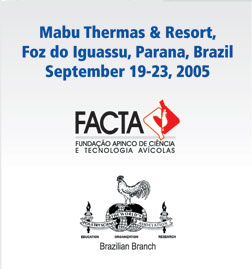Contributed Papers: Oral Presentations
Pathology |
THE ROLE OF
E. MITIS IN CHICKEN COCCIDIOSIS: A STUDY OF PATHOGENICITY
Luciano Gobbi and Raffaele Pezzotti
Schering-Plough Animal Health, Milan, Italy.
luciano.gobbi@spcorp.com
E. mitis is
one of seven known Eimeria species that infects chickens.
Its second Latin name, “mitis,” means
mild, because investigators of this pathogen have
always considered it to be of minor significance in
poultry.
E. mitis, however, is common in broilers and breeders.
It affects the large intestine, and produces large
amounts of small, almost round, oocysts, but it is
hard to identify because it does not cause gross lesions.
In addition, some studies indicate that E. mitis is
more pathogenic when it occurs concomitantly with
E. acervulina.
To further investigate E. mitis, a two-phase trial
was conducted. In the first phase, three groups of
14-day-old Ross 508 chickens were infected either
with E. mitis, E. acervulina or saline solution (negative
control); on days 4 and 14 after challenge, oocyst
shedding and bird performance were evaluated.
Oocyst counts demonstrated successful challenge with
both Eimeria species; peak numbers were hundreds of
thousands oocysts per gram (OPG) for E. mitis and
millions of OPG for E. acervulina.
Compared to controls, chickens infected with E. mitis
and E. acervulina had significantly lower daily weight
gain, feed intake, and water consumption, higher feed
conversion ratio, and lower final body weight. There
was a numerical, but not statistically significant
difference in water and feed intake between the two
infected groups.
In the second trial, three additional groups of 14-day-old
Ross 508 chickens were challenged with E. mitis and
E. acervulina, and then injected with Pontamine Sky
Blue dye, enabling evaluation of the intestinal mucosa.
Eimeria-infected chickens exhibited colour differences
in the mucosal surface as compared to controls. Permeability
was determined by increased transfer of dye, which
specifically binds to serum proteins and migrates
outside blood capillaries. Dye leakage between 72
and 144 hours post-infection stained intestinal mucosa
and gut contents, confirming cell damage and increased
gut permeability due to multiplication of both Eimeria
species.
Both Eimeria infections also caused a significant
gut wall thickening as measured by stereoscopic microscope
due to oedema and inflammation from 72 and 144 hours
post-infection.
The results indicate that E. mitis can impair chicken
performance and cause losses just like other, better
known Eimeria species. Consequently, the name E. mitis
does not, in fact, reflect the real pathogenicity
of this Eimeria species, hence, nomen non est omen.
